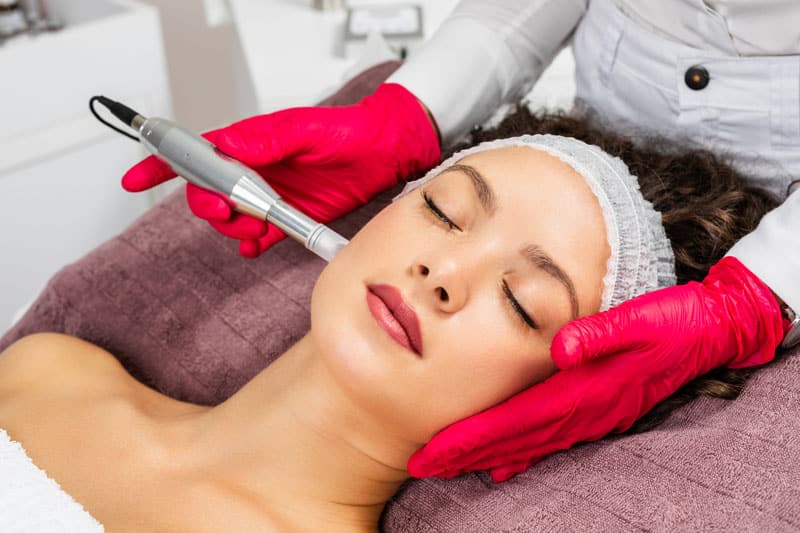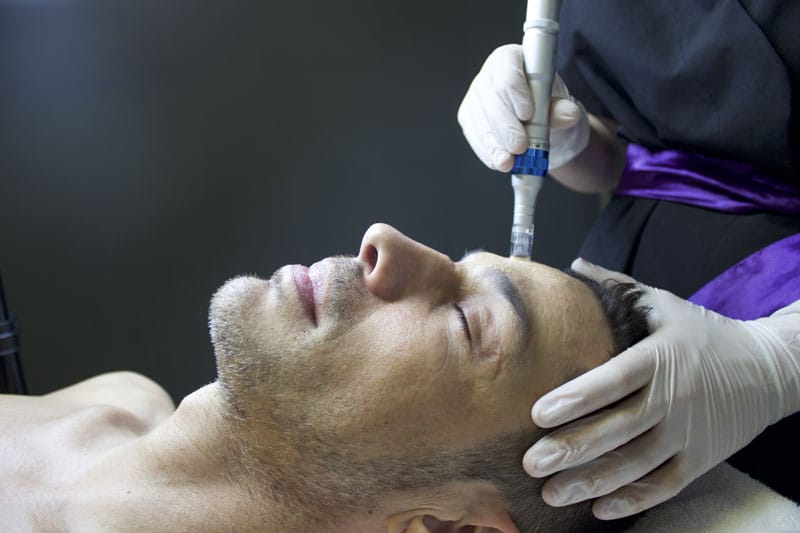Microneedling (percutaneous collagen induction therapy) is a minimally invasive procedure using thin needles. The procedure can help reduce the appearance of skin concerns such as acne scars, stretch marks or wrinkles. It also helps improve the appearance and texture of your skin.
Thin needles make tiny holes in the top layer of your skin. The damage helps stimulate your skin’s healing process, so it produces more collagen and elastin. These proteins keep your skin firm and smooth.
The microneedling pen is a thin handheld device that uses tiny needles to prick the top layer of your skin.
Most people get microneedling on their face, but you can also get it on your legs, back, neck or other areas where you notice damaged or aging skin. You’ll probably need multiple treatments to achieve your desired results.

Who gets microneedling?
Microneedling has cosmetic uses. You might consider microneedling if you’re concerned about:
- Enlarged pores
- Fine lines or wrinkles
- Loose or crepey (thin and wrinkled) skin
- Mild scars, especially those from acne or burns
- Skin discoloration or uneven skin tone
- Stretch Marks
What happens during treatment?
Before the procedure a topical anesthetic will be applied to the tratements areas to reduce any discomfort. After the anesthetic takes effect the treatment generally lasts 30 minutes but can vary depending on the size of the area being treated.
What happens after microneedling?
Your skin might turn red and swell for a short -term that can last for a few days. An ice pack can help reduce irritation and discomfort. Most people can wear makeup the day after the procedure, but you should stay out of the sun until your skin heals.

What are the benefits of microneedling?
Microneedling can help improve the appearance and texture of your skin. It can minimize stretch marks, scars, wrinkles and other skin concerns.
PRP (Platelet-Rich Plasma), Exosome, and PEP Growth Factor can improve your microneedling treatments to achieve amazing results!
It does not carry the risk of skin discoloration, unlike some facial rejuvenation procedures that use heat, light or lasers. This makes microneedling ideal for people with all skin types including darker skin tones.
What can I expect after microneedling?
In the first few days after treatment, you might notice that your skin feels like sunburn or feels tight. Some people may experience dry, flaking skin that improves with the recommended post care treatment.
Most people need multiple microneedling treatments, usually about 3 weeks to 8 weeks apart. It can take 3 months to 6 months to see results. Afterward, you might need the procedure once a year for maintenance.
Who shouldn’t have microneedling?
Talk to your healthcare provider before getting microneedling if you have:
- Acne or are taking medication for acne.
- Blood Disorders or are on anticoagulants (drugs that prevent blood clots).
- Cancer and are receiving chemotherapy or radiation therapy
- Frequent skin rashes or cold sores
- Keloidal tendency (your skin forms hard, raised scars).
- Moles, skin tags, lesions, or other growths that change in size or shape or bleed
- Skin conditions such as eczema or psoriasis
Call for individualized treatment to achieve your desired results. Schedule your appointment today!
LED Face Mask Light Therapy
In slightly simpler terms, LED light therapy “uses infrared light to achieve different effects on the skin,” explains Michele Farber, MD, a board-certified dermatologist based in Philadelphia, PA. During a treatment, “wavelengths in the visible light spectrum penetrate the skin to varying depths to exert biologic effect.” The different wavelengths are key, because this is “what helps make this method effective, as they penetrate the skin at varying depths and stimulate different cellular targets to help repair skin,” explains Ellen Marmur, MD, a board-certified dermatologist in New York City.
Which LED light colors benefit skin?
“Red and blue light are the most commonly used LED lights for skin therapy,” says Sejal Shah, MD, a board-certified dermatologist based in New York City. “Yellow and green have not been as well studied but have also been used for skin treatments,” she explains, and adds that the combination of blue and red light used at the same time is a “specialized treatment known as photodynamic therapy,” or PDT.
Red LED light
This color has been shown to “stimulate collagen production, reduce inflammation, and increase blood circulation,” Dr. Shah says, “so it is primarily used for [fine lines and wrinkles] and wound healing.” In terms of the former, because it boosts collagen, “red light is thought to [address] fine lines and wrinkles,” Dr. Farber explains.
Because of its healing properties, it may also be used as an add-on after other in-office procedures, such as laser or microneedling, to reduce inflammation and recovery time, Shah says. According to aesthetician Joanna Vargas, this means she can perform “an intense peel on someone that can normally leave [their skin] red for hours, but then use infrared afterward and they walk out not red at all.”
Red light therapy may also help ease inflammatory skin conditions like rosacea and psoriasis.
Blue LED light
“There is encouraging evidence that blue LED light can alter the microbiome of the skin to improve acne,” says Dr. Belkin. Specifically, studies have shown that with continued use, blue LED light can help kill acne-causing bacteria and also reduce oil production in the skin’s sebaceous glands.
The various light colors may work to differing degrees, says Bruce Brod, a clinical professor of dermatology at the University of Pennsylvania. “Clinical studies [are] relatively consistent in showing a reduction in acne bumps when [blue light] is used regularly,” he says. What we know for now, according to Dr. Brod, is that blue light has a “mild benefit for certain types of acne.”

